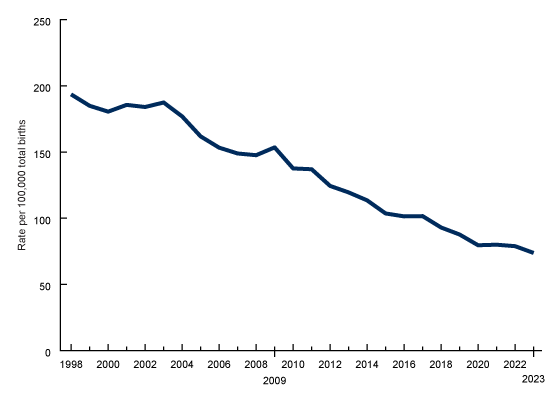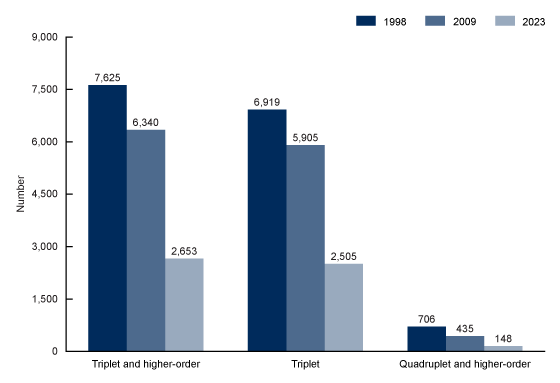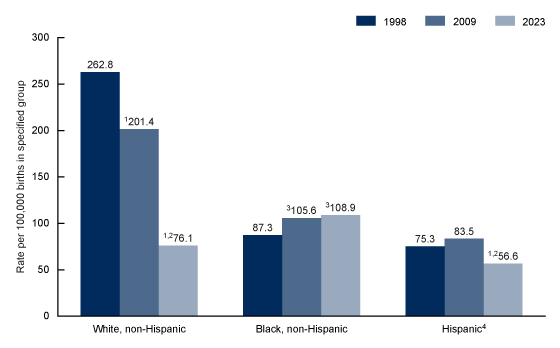Declines in Triplet and Higher-order Multiple Births in the United States, 1998–2023
- Key findings
- The triplet and higher-order multiple birth rate declined from 1998 to 2023, with most of the decline starting in 2009.
- The number of triplet and higher-order, triplet, and quadruplet and higher-order births declined from 1998 to 2023.
- From 1998 to 2023, triplet and higher-order birth rates declined for White and Hispanic mothers and rose for Black mothers.
- Triplet and higher-order multiple birth rates declined for all mothers age 20 and older from 1998 to 2023.
Data from the National Vital Statistics System
- From 1998 to 2023, the triplet and higher-order multiple birth rate declined from 193.5 to 73.8 births per 100,000 total births; the largest declines were from 2009 to 2023.
- From 1998 to 2023, the number of triplet and higher-order births declined from 7,625 to 2,653.
- Declines from 1998 to 2023 in triplet and higher-order birth rates were observed for White non-Hispanic (71%) and Hispanic (25%) mothers, while the rate for Black non-Hispanic mothers increased (25%).
- Triplet and higher-order birth rates declined for all age groups 20 and older from 1998 to 2023, and the largest declines were for mothers age 30 and older.
The unprecedented rise in the triplet and higher-order multiple birth rate from 37.0 to 193.5 births per 100,000 births between 1980 and 1998 (1,2) was associated with older maternal age and the increased use of fertility treatments (3,4). The increase was of public health concern because of the greater risk of adverse maternal and infant health outcomes of triplet and higher-order births compared with twins and singletons (5,6). Since 1998, however, the incidence of these births has trended downward (7). This report explores changes in the overall rate of triplet and higher-order births from 1998 to 2023 by detailed plurality, maternal race and Hispanic origin, and age.
Keywords: maternal age, race and Hispanic origin, state, National Vital Statistics System
The triplet and higher-order multiple birth rate declined from 1998 to 2023, with most of the decline starting in 2009.
- From 1998 to 2023, the triplet and higher-order multiple birth rate declined 62%, from 193.5 per 100,000 total births to 73.8 (Figure 1, Table 1).
- From 1998 to 2009, rates declined but not significantly, by 21% (153.5 in 2009), and then declined significantly by 52% from 2009 to 2023.
Figure 1. Triplet and higher-order multiple birth rate: United States, 1998–2023

NOTES: No significant trend was observed from 1998 to 2009; a significant declining trend was observed from 2009 to 2023 (p < 0.05). Triplet and higher-order births are births in triplet and higher-order pregnancies.
SOURCE: National Center for Health Statistics, National Vital Statistics System, natality data file.
The number of triplet and higher-order, triplet, and quadruplet and higher-order births declined from 1998 to 2023.
- The number of triplet and higher-order multiple births declined from 7,625 in 1998 to 6,340 in 2009, then to 2,653 in 2023, for a total decline of 65% from 1998 to 2023 (Figure 2, Table 2).
- The number of triplet births, which comprise most triplet and higher-order births, followed a similar pattern, with a larger decline from 2009 (5,905) to 2023 (2,505) compared with 1998 (6,919 births).
- The number of quadruplet and higher-order births declined from 706 in 1998 to 435 in 2009, then to 148 births in 2023, a decline of 79% from 1998 to 2023.
Figure 2. Number of triplet and higher-order, triplet, and quadruplet and higher-order multiple births: United States, 1998, 2009, and 2023

NOTES: Significant declines were observed between all years for each plurality (p < 0.05). Triplet and higher-order births are births in triplet and higher-order pregnancies.
SOURCE: National Center for Health Statistics, National Vital Statistics System, natality data file.
From 1998 to 2023, triplet and higher-order birth rates declined for White and Hispanic mothers and rose for Black mothers.
- Among White non-Hispanic (subsequently, White) mothers, the triplet and higher-order multiple birth rate declined 23% from 1998 to 2009 (262.8 per 100,000 births to 201.4) and by 62% from 2009 to 2023 (76.1), for a total decline of 71% (Figure 3, Table 3).
- Triplet and higher-order births for Hispanic mothers did not change significantly from 1998 to 2009 (75.3 to 83.5) but declined 32% from 2009 to 2023 (56.6), for a decline of 25% from 1998 to 2023.
- In contrast, the triplet and higher-order birth rate for Black non-Hispanic (subsequently, Black) mothers rose 21% from 1998 to 2009 (87.3 to 105.6) and did not change significantly from 2009 to 2023 (108.9), for an overall increase of 25% from 1998 to 2023.
Figure 3. Triplet and higher-order multiple birth rate, by race and Hispanic origin of mother: United States, 1998, 2009, and 2023

1Significant decline from 1998 (p < 0.05).
2Significant decline from 2009 (p < 0.05).
3Significant increase from 1998 (p < 0.05).
4People of Hispanic origin may be of any race.
NOTES: Significant differences were observed between each race and Hispanic-origin group for all years (p < 0.05). Triplet and higher-order births are births in triplet and higher-order pregnancies.
SOURCE: National Center for Health Statistics, National Vital Statistics System, natality data file.
Triplet and higher-order multiple birth rates declined for all mothers age 20 and older from 1998 to 2023.
- From 1998 to 2023, triplet and higher-order multiple birth rates declined 16% for mothers ages 20–24 (47.8 per 100,000 births to 40.2), and 57% for mothers ages 25–29 (156.2 to 67.4) (Figure 4, Table 4). The decline in the rate for mothers younger than 20 (17.6 to 16.1) was not significant.
- The largest declines in rates by maternal age from 1998 to 2023 were for mothers age 30 and older: 77% for both mothers ages 30–34 (360.4 to 82.1) and 35–39 (409.8 to 93.9), and 67% for mothers age 40 and older (517.6 to 168.6).
- Over the period, declines by maternal age were greater between 2009 and 2023 for women age 25 and older. For example, the rate for mothers ages 35–39 declined by 71% between 2009 and 2023, compared with a 20% decline between 1998 and 2009.
Figure 4. Triplet and higher-order multiple birth rate, by age of mother: United States, 1998,
2009, and 2023

1Significant decline from 1998 (p < 0.05).
2Significant decline from 2009 (p < 0.05).
NOTES: A significant increasing trend by age was observed for 1998, 2009, and 2023 (p < 0.05). Triplet and higher-order births are births in triplet and higher-order pregnancies.
SOURCE: National Center for Health Statistics, National Vital Statistics System, natality data file.
Summary
The triplet and higher-order birth rate declined 62% from 1998 to 2023; the number of triplet births declined by a similar amount (64%), and the number of quadruplet and higher-order births declined by more than three-quarters (79%). Declines in both rates and numbers were larger from 2009 to 2023 compared with 1998 to 2009.
By race and Hispanic origin, the largest decline from 1998 to 2023 in triplet and higher-order birth rates was for White mothers, down 71%, compared with a 25% decline for Hispanic mothers and a 25% increase for Black mothers. Rates declined for all maternal age groups 20 and older, with the largest declines among mothers 30 and older (67%–77%).
While the 2023 rate of triplet and higher-order births in the United States (73.8 per 100,000 total births) remained higher than rates reported before the use of fertility treatments became more widespread in the early to mid-1980s, the 2023 rate was less than one-half of the 1998 peak (193.5) and similar to rates reported in the early 1990s (1). This decline in triplet and higher-order births over the last 25 years has been associated with changes to guidance related to the number of embryos transferred during assisted reproductive technology use (8–10).
Definitions
Quadruplet and higher-order birth: Individual live birth in a quadruplet or higher-order multiple delivery pregnancy.
Quadruplet and higher-order birth rate: The number of quadruplet or higher-order multiple births per 100,000 total births.
Triplet birth: Individual live birth in a triplet pregnancy.
Triplet birth rate: The number of triplet births per 100,000 total births.
Triplet and higher-order birth: Individual live birth in a triplet and other higher-order multiple delivery pregnancy.
Triplet and higher-order birth rate: The number of triplet and higher-order multiple births per 100,000 total births.
Data sources and methods
This report is based on birth certificate data from the National Vital Statistics System. The vital statistics natality file includes information for all births occurring in the United States in a given year and includes a wide range of information on demographic and health characteristics for mothers and infants. Provisional and final data may also be accessed through the Centers for Disease Control and Prevention’s Wide-ranging Online Data for Epidemiologic Research (WONDER) at: https://wonder.cdc.gov/Natality.html.
This report presents rates of live births in triplet and higher-order pregnancies. A triplet and higher-order pregnancy is one in which the number of fetuses delivered live or dead at any given time in the pregnancy is equal to three or more, regardless of gestational age or if the fetuses were delivered at different times during the pregnancy.
Trends in the rate of triplet and higher-order births from 1998 to 2023 were evaluated using the Joinpoint Regression Program (11). The year 2009 was chosen as a comparison point because it is the only point of inflection in the Joinpoint regression analysis. Differences between rates noted in the text are statistically significant at the 0.05 level unless otherwise noted and are based on a pairwise comparison using a two-tailed z test.
Data for 1998 are based on the bridged race of the mother; data for 2009 and 2023 are single race (12). Because of the small number of triplet and higher-order births, data for smaller race and Hispanic-origin groups are not presented.
About the authors
Joyce A. Martin and Michelle J.K. Osterman are with the National Center for Health Statistics, Division of Vital Statistics.
References
- Martin JA, Park MM. Trends in twin and triplet births: 1980–1997. National Vital Statistics Reports; vol 47 no 24. Hyattsville, Maryland: National Center for Health Statistics. 1999.
- Ventura SJ, Martin JA, Curtin SC, Matthews TJ, Park MM. Births: Final data for 1998. National Vital Statistics Reports; vol 48 no 3. Hyattsville, MD: National Center for Health Statistics. 2000.
- Reynolds MA, Schieve LA, Martin JA, Jeng G, Macaluso M. Trends in multiple births conceived using assisted reproductive technology, United States, 1997–2000. Pediatrics 111(5 Pt 2):1159–62. 2003.
- Kulkarni AD, Jamieson DJ, Jones HW, Kissin DM, Gallo MF, Macaluso M, Adashi EY. Fertility treatments and multiple births in the United States. N Engl J Med 369(23):2218–25. 2013.
- Ely DM, Driscoll AK. Infant mortality in the United States, 2022: Data from the period linked birth/infant death file. National Vital Statistics Reports; vol 73 no 5. Hyattsville, MD: National Center for Health Statistics. 2024. DOI: https://dx.doi.org/10.15620/cdc/157006.
- Luke B, Brown MB. Contemporary risks of maternal morbidity and adverse outcomes with increasing maternal age and plurality. Fertil Steril 88(2):283–93. 2007.
- Osterman MJK, Hamilton BE, Martin JA, Driscoll AK, Valenzuela CP. Births: Final data for 2022. National Vital Statistics Reports; vol 73, no 2. Hyattsville, MD: National Center for Health Statistics. 2024. DOI: https://dx.doi.org/10.15620/cdc:145588.
- Practice Committee of the American Society for Reproductive Medicine and the Practice Committee for the Society for Assisted Reproductive Technologies. Guidance on the limits to the number of embryos to transfer: A committee opinion. Fertil Steril 116(3): 651–4. 2021.
- Katler QS, Kawwass JF, Hurst BS, Sparks AE, McCulloh DH, Wantman E, Toner JP. Vanquishing multiple pregnancy in invitro fertilization in the United States—a 25-year endeavor. Am J Obstet Gynecol 227(2):129–5. 2022.
- Adashi EY, Penzias AS, Gruppuso PA, Kulkarni AD, Zhang Y, Kissin DM, Gutman R. Iatrogenic and demographic determinants of the national plural birth increase. Fertil Steril 121(5):756–64. DOI: https://dx.doi.org/10.1016/j.fertnstert.2024.01.024.
- National Cancer Institute. Joinpoint Regression Program (Version 5.0.2) [computer software]. 2023.
- National Center for Health Statistics. User guide to the 2021 natality public use file. 2022.
Suggested citation
Martin JA, Osterman MJK. Declines in triplet and higher-order multiple births in the United States, 1998–2023. NCHS Data Brief, no 512. Hyattsville, MD: National Center for Health Statistics. 2024. DOI: https://dx.doi.org/10.15620/cdc/164017.
Copyright information
All material appearing in this report is in the public domain and may be reproduced or copied without permission; citation as to source, however, is appreciated.
National Center for Health Statistics
Brian C. Moyer, Ph.D., Director
Amy M. Branum, Ph.D., Associate Director for Science
Division of Vital Statistics
Paul D. Sutton, Ph.D., Acting Director
Andrés A. Berruti, Ph.D., M.A., Associate Director for Science